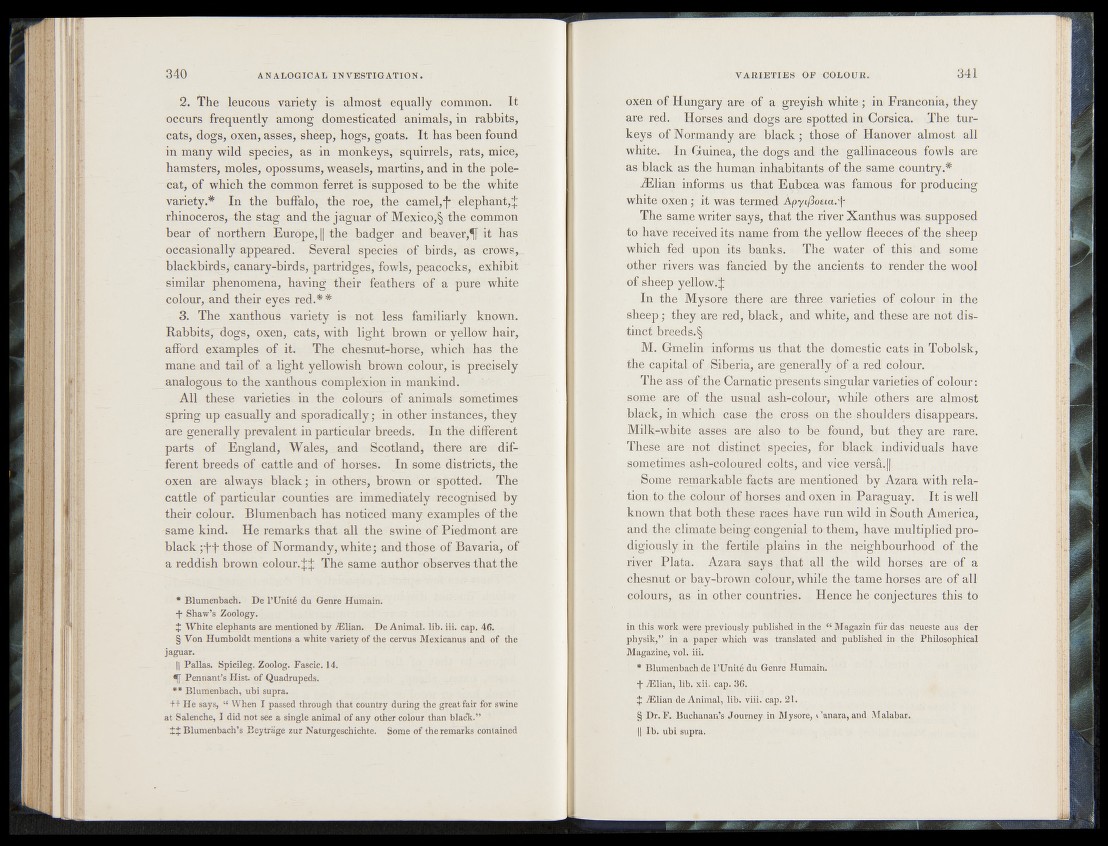
2. The leucous variety is almost -equally common. It
occurs frequently among domesticated . animals, in rabbits,
cats, dogs, oxen, asses, sheep, hogs, goats, It has been found
in many wild species, as in monkeys,' squirrels, rats, mice,
hamsters, moles, opossums, weasels, martins, and in the polecat,
of which the common ferret is supposed to be the white
variety.* In the buffalo, the roe, the camel,*}* elephant,£
rhinoceros, the stag and the jaguar of Mexico,§ the common
bear of northern Europe, || the badger and b e a v e r ,it has
occasionally appeared. Several species of birds, as crows,
blackbirds, canary-birds, partridges, fowls, peacocks, exhibit
similar phenomena, having their feathers of a pure white
colour, and their eyes red .* *
3. The xanthous variety is not less familiarly known.
Rabbits^" dogs, oxen, cats, with light brown or yellow hair,
afford examples of it. The chesnut-horse, which has the
mana and tail of. a light yellowish brown ^colour, te precisely
analogous to the xanthous complexion in mankind.
All these varieties m the colours of animals sometimes
spring up casually and sporadically ; in other. in stan c e sth ey
are generally prevalent in particular breeds. In the different
parts of England, Wales, and Scotland, there are dif-;
ferent breeds of cattle and of horses. In some districts, the
oxen are always black; in others, brown or spotted. The
cattle of particular counties are immediately recognised by
their colour. Blumenbaeh has noticed many examples of the
same kind. He remarks that all the swine of Piedmont are
black ;*j*f those of Normandy, white; and those of Bavaria, o f
a reddish brown colour.^ The same author observes that the *
§* Blumenbaeh. De l’Urrité du Genre Humain.
-J- Shaw’s Zoology.
J White elephants are mentioned by M H a ru De Animal, lib. iii. cap. 4(5.
§ Von Humboldt mentions a white variety of the cervus Mexicanus and of the
jaguar.
|| Fallas. Spidleg. Zoolog. Fascic. 14.
Pennant’s Hist, of Quadrupeds.
** Blumenbaeh, ubi supra.
++ He says, “ When I passed through that country during the great fair for swine
at Salenche, 1 did not see a single animal of any other colour than black.”
±4: Blumenbach’s Beytrage zur Naturgeschichte. Some of the remarks contained
oxen of Hungary are of a. greyish white; in Franconia, they
are red. Horses and dogs are; spotted in Corsica. The turkeys
of Noi^snandy >are< .black ; those«of Hanover almost all
white.^ i. In Guinea, the dogsjands the gallinaceous fowls are
as black as the human inhabitants of the same, country.*
iElian informs us that Euboea was famous for producing
white: .o x e n i t was termed Apyifioeia.'f
The same writer says, that the river Xanthus was, supposed
to have received its name fromithe yellow' flejeges, of the sheep
which fed upon its banks. The water .of this' and some
other rivers was fancied by the ancients to render the wool
of sheep yellow.£
In the Mysore there are three varieties of■scolqur, in the
sheep; they are red, black, and white* and theSe, are not distinct
breeds.>§,>,
M. Gmelin;Tmforms ns that the domestic cats-in Tobolsk,
the capital of/Siberia, are generally of a red colour.
The ass‘of"the Carnatic presents singular varieties of colour:
some are of the; usual ash-colour*-. while othejrs^ are almost
black, in which case- thev .erQSB.pn the-shoulders disappears.
Milk-white asses are also to^b^ Tound, but they are rare.
The.se are not distinct' species,(for black* individuals have
sometimes, ash-coloured cplts; and';yice\yersa'.:||t j
:.Some remarkable facts are mentioned by Azara with relation
to the colour of horses and oxen im,Paraguay., It is well
known that both, these races have run wild in South America,
and the climate bqing congenial to;them, have multiplied prodigiously
in the fertile -plains in the .neighbourhood., of „the
river Plata; Azara says That all the wild horses are of a.
chesnut or bay-brown Colour, while the; tame horses are of all
colours, as in other countries. Hence he conjectures this to
in this work were previously published in the “ Magazin für das neueste aus der
physik,” in a paper which was translated and published in the Philosophical
Magazine, vol. iii.
* Blumenbaeh die l ’Unit6 du Genre Humain.
•J* ./Elian, lib. xii. cap. 36.
$ ASlian de Animal, lib. viü. cap. 21.
, § Dr. F. Buchanan’s Journey in Mysore, > ’anara, and Malabar.
|j lb. ubi supra.